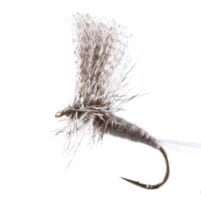Your cart is currently empty!
Gray Drake Dun Thorax mayfly
The Gray Drake Dun Thorax represents a masterful evolution in mayfly imitation, featuring an innovative thorax design that provides exceptional buoyancy and balance, particularly in smaller hook sizes.
Description
Product Overview and Heritage
The Gray Drake Dun Thorax mayfly represents a masterful evolution in mayfly imitation, featuring an innovative thorax design that provides exceptional buoyancy and balance, particularly in smaller hook sizes. This specialized pattern has been crafted to perfectly match the dun stage of Gray Drake mayflies (Siphlonurus), making it particularly effective during hatches. The pattern’s enhanced thorax design and precise proportions create a highly effective imitation that consistently produces results in various water conditions.
Design Philosophy and Material Innovation
The pattern’s effectiveness stems from its carefully engineered components:
- Specialized thorax design
- Premium hackle materials
- Precise body proportions
- Exact wing placement
- Durable construction
- Realistic profile
- Strategic material selection
- Enhanced buoyancy features
- Advanced tying techniques
- Natural movement properties
Technical Specifications
Hook Characteristics:
- Standard dry fly hook
- Available sizes: 10-14
- Light wire construction
- Standard-eye design
- Chemically sharpened points
- Wide gape configuration
- Bronze finish
- Optimal hook strength
- Enhanced penetration design
- Perfect size-to-weight ratio
Material Properties:
- Selected thorax dubbing
- Premium hackle
- Specialized wing material
- Water-resistant treatments
- Enhanced durability features
- Quality natural materials
- Specialized body construction
- Color-fast characteristics
- Float enhancement
- Profile consistency
Construction and Tying Process
The pattern’s success relies on precise construction methods:
- Balanced proportions
- Strategic thorax building
- Graduated body tapering
- Reinforced wing ties
- Material integration
- Enhanced durability features
- Proper hackle application
- Body segmentation
- Profile consistency
- Float optimization
Fishing Applications and Techniques
Presentation Methods:
- Dead drift
- Downstream presentation
- Multiple drift angles
- Drag management
- Pattern placement
- Drag-free drifts
- Current seam fishing
- Structure targeting
- Cross-current drifts
- Action variation
Specialized Applications:
- Gray Drake hatches
- Evening fishing
- Technical water
- High-pressure situations
- Structure fishing
- Pocket water
- Bank fishing
- Seam fishing
- Drop-offs
- Current breaks
Seasonal Effectiveness
Spring Performance:
- Early season hatches
- Warming waters
- Initial emergence
- Water level variations
- Mixed techniques
- Weather changes
- Pattern selection
- Temperature increases
- Fish movement
- Feeding windows
Summer Strategy:
- Peak hatch periods
- Evening activity
- Temperature changes
- Feeding patterns
- Oxygen levels
- Light penetration
- Fish behavior
- Water conditions
- Current seams
- Structure targeting
Fall Applications:
- Late season hatches
- Cooling waters
- Changed light conditions
- Transitional periods
- Selective takes
- Pattern visibility
- Fish location
- Temperature drops
- Migration patterns
- Feeding windows
Winter Tactics:
- Limited opportunities
- Cold water periods
- Slow presentations
- Temperature considerations
- Pattern visibility
- Fish holding patterns
- Oxygen levels
- Light penetration
- Feeding windows
- Cold water techniques
Habitat and Water Types
Water Applications:
- Spring creeks
- Tailwaters
- Mountain streams
- Lakes and ponds
- Clear pools
- Structure areas
- Current seams
- Drop-offs
- Holding water
- Pocket water
Specialized Environments:
- Crystal clear waters
- Stained conditions
- Shallow riffles
- Deep runs
- Complex currents
- Bank structure
- Channel edges
- Boulder gardens
- Undercut banks
- Current breaks
Target Species and Behavior
Primary Species:
- Brown Trout
- Rainbow Trout
- Brook Trout
- Cutthroat Trout
- Grayling
- Whitefish
- Selective Trout
- Technical Water Species
Feeding Behaviors:
- Surface inspection
- Selective takes
- Pattern recognition
- Territorial behavior
- Opportunistic takes
- Selective feeding
- Strike triggers
- Visual stimulation
- Lateral line response
- Competitive feeding
Rigging Recommendations
Leader Setup:
- 9-12 foot leaders
- 5X-6X tippet
- Tapered leaders
- Fluorocarbon options
- Loop-to-loop connections
- Delicate presentation
- Proper stiffness
- Knot strength
- Breaking strain
- Abrasion resistance
Presentation Options:
- Single fly rigs
- Double dry fly rigs
- Multiple fly systems
- Traditional methods
- Modern techniques
- Line matching
- Leader design
- Tippet selection
- Float enhancement
- Depth control
Professional Applications
Guide Usage:
- Client-friendly pattern
- Proven success rates
- Visibility advantages
- Easy presentation
- Multiple techniques
- Teaching tool
- Confidence pattern
- Versatile applications
- Durability
- Hook-up ratio
Competition Usage:
- Tournament proven
- Technical water success
- Pressure adaptation
- Quick-change capability
- Consistent performance
- Visibility control
- Pattern rotation
- Size variation
- Color selection
- Presentation options
Care and Maintenance
Post-Fishing Care:
- Thorough drying
- Material grooming
- Hook point inspection
- Thorax maintenance
- Hackle preservation
- Storage preparation
- UV protection
- Pattern inspection
- Shape verification
- Float testing
Storage Requirements:
- Dry environment
- UV protection
- Separate compartments
- Regular inspection
- Moisture prevention
- Temperature control
- Light protection
- Ventilation needs
- Box organization
- Inventory management
Advanced Fishing Methods
Presentation Techniques:
- Drift variations
- Drag control
- Strike detection
- Drift management
- Current reading
- Structure approach
- Pattern tracking
- Recovery methods
- Angle optimization
- Tension control
Water Reading:
- Current understanding
- Depth assessment
- Structure location
- Fish holding areas
- Presentation angles
- Feeding lanes
- Travel routes
- Rest areas
- Temperature breaks
- Current seams
Environmental Considerations
Conservation Features:
- Barbless options
- Sustainable materials
- Durable construction
- Catch-and-release friendly
- Minimal environmental impact
- Eco-conscious design
- Material selection
- Ethical considerations
- Resource protection
- Species conservation
Material Selection:
- Responsible sourcing
- Quality components
- Natural elements
- Ethical production
- Sustainable practices
- Environmental impact
- Material longevity
- Waste reduction
- Local materials
- Eco-conscious design
-
Enhance your trout fishing with the Gray Drake Dun Thorax Mayfly, a premium dry fly designed for realistic Gray Drake hatches. Featuring an enhanced thorax for better buoyancy and lifelike movement, this fly is perfect for trout, grayling, and other freshwater species.
Why Choose Gray Drake Dun Thorax Mayfly:
-
Realistic Gray Drake Design: Accurately mimics natural insects during Gray Drake hatches.
-
Superior Buoyancy: Enhanced thorax keeps the fly floating naturally on the water surface.
-
Durable Construction: Premium materials and strong hooks for repeated use.
-
Versatile Fishing: Ideal for rivers, streams, lakes, and reservoirs.
-
Catch & Release Friendly: Gentle on fish for responsible angling.
Product Features:
-
Material: Natural feathers and synthetic fibers
-
Fly Type: Dry fly
-
Target Species: Trout, Grayling
-
Best Use: Gray Drake hatch fishing / Surface fishing
-
Pack Size: Single or bulk
Fishing Tips:
-
Cast upstream and allow the fly to drift naturally.
-
Use short twitches or gentle mends to mimic insect movement.
-
Target riffles, pools, and runs where trout feed during hatches.
Why Anglers Prefer Gray Drake Dun Thorax Mayfly:
Anglers rely on the Gray Drake Dun Thorax Mayfly for its proven effectiveness during Gray Drake hatches. Perfect for both beginners and seasoned anglers, this fly ensures a realistic presentation that attracts more strikes. -
Additional information
| Hook size | 10, 12, 14, 16, 18, 20 |
|---|---|
| Hook type | Barbed Hooks, Barbless Hooks |







